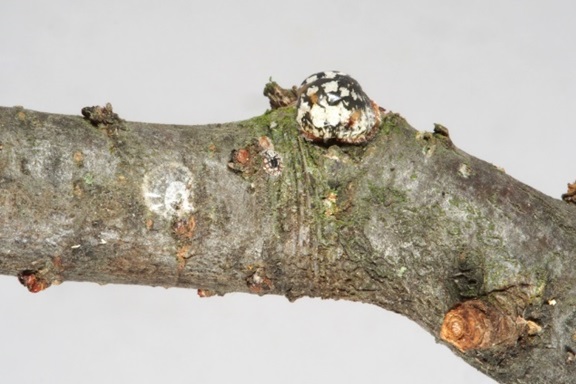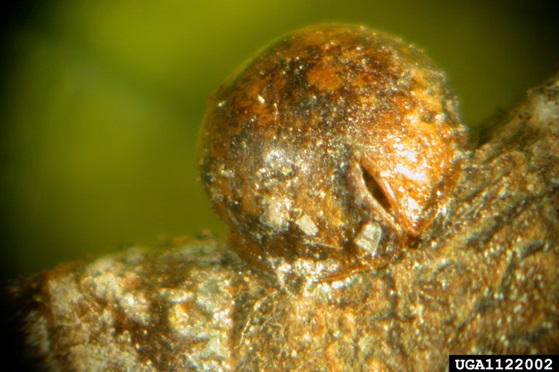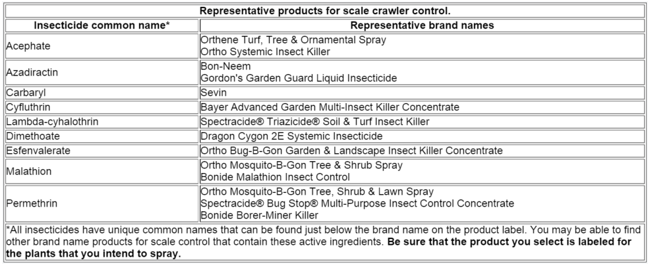The Challenges of Calico Scale Control
ENTFACT-466: The Challenges of Calico Scale Control | Download PDF
by Jonathan Larson, Extension Entomologist
University of Kentucky College of Agriculture
Fast Facts
- Calico scales are soft scales, a type of sap-sucking pest. They are about ¼ inch in diameter, puffy, with a mix of white and darker colors, giving them a calico appearance.
- This pest has a broad host range and can be found on honeylocust, maple, dogwood, oak, redbud, elm, and crabapple among many other species.
- As they feed, they can induce leaf yellowing and twig dieback, but the most obvious symptom is a large amount of honeydew, a sticky waste material that will accumulate on the plant and other surfaces and produce sooty mold.
- Management is difficult due to a long crawler window and variable effectiveness of systemic insecticides. Crawler control is possible, if timed correctly, and physical removal by scrubbing trees can help too.
Potential Hosts
Calico scale can feed on a variety of host plants. Possible hosts include, but are not limited to crabapple, elm, pyracantha, honeylocust, maple, oak, dogwood, buckeye, hackberry, hawthorn, magnolia, redbud, sweetgum, tuliptree, stone fruit trees, and zelkova.
Symptoms and Pest Description

Figure 1. Mature, female calico scales are 1/4th inch in diameter, bulbous, with blotchy black, white, and brown coloration (hence the calico name). (Photo: Jim Kalisch, University of Nebraska-Lincoln).
Scale insects are “sucking pests,” meaning they use a needle like mouth to siphon fluids from plants. Calico scales are part of the “soft scale” group, meaning that they do not produce a waxy shield that covers their body.
Soft scales are known for their ability to produce substantial amounts of honeydew. Since these insects are processing/feeding on sugary sap all day, they also expel honeydew, a sugary, water-like substance. Accumulations of honeydew are shiny and sticky and may also recruit black sooty mold fungus which feeds on honeydew and may be found growing in patches on branches and trunks. Honeydew may also recruit other insects to visit the scales. Ants, wasps, and others will consume the sugary feces and may be more noticeable than the scale insects themselves. Aside from honeydew, calico scale can induce leaf yellowing and twig dieback.
Calico scales reach about ¼ inch in diameter. Their name comes from their mixed coloration of brown, white, and black which can resemble a calico animal. In the spring as they mature, the scale takes on a puffy, globular appearance. Once females die, they will transition to a dull brown color. Calico scale crawlers are initially pink but transition to yellow as they age.

Figure 2. Calico scale females become puffy and globular as they mature. Once they have produced their eggs, they will start to lose their original coloration and take on a faded, brown appearance. (Photo: Eric R. Day, Virginia Polytechnic Institute and State University)
Life Cycle in Kentucky
Calico scales overwinter as immature crawlers on the branches and limbs of their host tree. In the spring, these immature scales will resume feeding and continue to grow and mature. Females swell as they feed and will lay eggs by mid-May. Soon afterwards she will die, and the eggs will hatch. Calico crawler activity has a large window, spreading between June and July. Crawlers initially settle and feed on the leaves, but as autumn approaches will move to twigs and branches to find an overwintering site. There is one generation per year.
Management
Calico scales can be difficult pests to manage. Generally, scales tend to thrive on stressed plants. Following a recommended fertility program and watering regime will promote plant health. However, over-fertilization favors scale buildup. If practical, improve plant sites to reduce stress and promote growth.
On smaller trees, there has been success when using scrub brushes to physically remove calico scale. It may take repeated attempts and require elbow grease but it is an option that should be considered.
Normally, there are two options when considering management of scales: doing a systemic treatment, or treating the crawlers directly. Systemic insecticides have had variable efficacy against calico scales in university trials. For that reason, control is normally focused on treating immature crawlers.
Treating Crawlers Directly
In comparison to adults, crawlers are the most susceptible stage of a scale insect’s life. To treat the crawlers, you should be monitoring for their emergence. You can visually check in June-July and for calico scale crawlers. Alternatively, you can place pieces of black electrical tape (sticky side out) or double-sided tape near scale populations and monitor the tape for the crawlers and treat following the initial find.
Horticultural oils kill crawlers by suffocation or after penetrating over-wintering stages of the insect. Consequently, they may not be effective where several layers of scale coverings have accumulated. Insecticidal soaps are long-chain fatty acids that kill susceptible insects through direct contact. Like horticultural oils, they require thorough coverage. Soaps leave no residue so repeated applications may be needed for some pests. These products may burn the foliage of sensitive plants, such as Japanese maple, so check the label for information about the plant species that you intend to treat.
A variety of natural and synthetic insecticides are labeled for use as sprays to control scale crawlers on landscape trees and shrubs. While the residual life of these products is generally longer than oils and soaps, timing, coverage, and precautions on damage to some plant species are similar to those for oils and soaps.
Below are some options for scale insect crawler control.

Evaluating Control
The success or failure of control efforts may not be readily apparent but here are some things to check.
- Live scales should produce a liquid when mashed, dead scales will be dry and not "bleed" when crushed.
- New foliage should have a healthier appearance once the scale burden has been removed. Buds should break a little earlier than when the plant was infested, and expanded leaves should have normal color and turgor.
Issued: 05/22
CAUTION! Pesticide recommendations in this publication are registered for use in Kentucky, USA ONLY! The use of some products may not be legal in your state or country. Please check with your local county agent or regulatory official before using any pesticide mentioned in this publication.
Of course, ALWAYS READ AND FOLLOW LABEL DIRECTIONS FOR SAFE USE OF ANY PESTICIDE!
